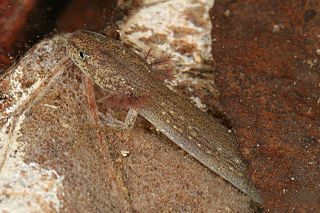
The Barton Springs salamander is an endangered lungless salamander. It is endemic to Texas, United States. It was first found in Barton Springs in Austin, but is now also known from other localities in the nearby Travis and Hays Counties. Barton Springs is located within Zilker Park which is situated in the Edwards Aquifer in Austin, Texas. Eliza Springs, located within Barton Springs, has one of the largest populations of Barton Springs salamanders.

The San Marcos salamander is a small species of aquatic, lungless salamander native to the United States, endemic to Spring Lake and a small region of the headwaters of the San Marcos River near Aquarena Springs, in Hays County, Texas. It is one to two inches long, with a slender body and external gills, and is a reddish-brown in color.
The Comal blind salamander or Honey Creek Cave blind salamander is a small species of aquatic, lungless salamander native to the United States. It is endemic to a small region at the junction of Comal, Bexar and Kendall Counties in Texas. It is 1.5 to 3.0 in long, with a slender body and external gills, and is an overall translucent pink color.
Eurycea neotenes, also known as the Texas salamander, Bexar County salamander, Edwards Plateau salamander, or Texas neotenic salamander, is a species of entirely aquatic, lungless salamander native to the United States. It is endemic to central Texas, near Helotes, in Bexar County.

The northern two-lined salamander is a species of salamander in the family Plethodontidae found in Canada and the United States. Its natural habitats are temperate forests, temperate shrubland, rivers, intermittent rivers, freshwater marshes, freshwater springs, arable land, and urban areas. It is more water-oriented than the related northern redback salamander, and can often be found in and around water such as rain puddles, streams, swamps, and damp stream beds, whereas the northern redback tends to be found in damp ground, but usually not near open water.
The Salado Springs salamander is a species of salamander in the family Plethodontidae. It is endemic to the vicinity of Salado, Texas.

The southern two-lined salamander is a species of salamander in the family Plethodontidae, endemic to the United States. Its natural habitats are temperate forests, rivers, intermittent rivers, swamps, and freshwater springs.

The many-ribbed salamander is a species of salamander in the family Plethodontidae, endemic to the United States. Its natural habitats are temperate forests, rivers, freshwater springs, inland karsts, and caves.

The Jollyville Plateau salamander is a species of salamander in the family Plethodontidae. It is also known as the Tonkawa Springs salamander. It is endemic to Travis and Williamson counties, Texas, United States. This species is perrenibranchiate, retaining its gills throughout life.
The Georgia blind salamander is a species of salamander in the family Plethodontidae. It is endemic to the south-eastern United States where its natural habitats are inland karsts, caves and subterranean habitats. It is listed as "Vulnerable" by the IUCN and is threatened by habitat loss.

The westerngrotto salamander, also called the Ozark blind salamander and previously known as just the grotto salamander, is a species of salamander in the family Plethodontidae. It is endemic to the United States. Its natural habitats are freshwater springs, inland karsts, and caves. It is not currently threatened, but vulnerable to changes in groundwater quality and reduction in bat population.

The spotted-tail salamander, also known as a "cave salamander", is a species of brook salamander.

A cave salamander is a type of salamander that primarily or exclusively inhabits caves, a group that includes several species. Some of these animals have developed special, even extreme, adaptations to their subterranean environments. Some species have only rudimentary eyes. Others lack pigmentation, rendering them a pale yellowish or pinkish color.
The Carolina Sandhills salamander, is a species of lungless salamander endemic to the state of North Carolina in the United States, where it is only found in the Sandhills region. These species are known for their coloration and ecology. Researchers decades ago separated the species into northern and southern groups and found that the southern and northern Sandhill salamanders differ in coloration, size, and natural history.
Hillis's dwarf salamander is a species of salamander endemic to the southern United States.
Dwarf salamander may refer to five species of salamander in the genus Eurycea, all endemic to the United States and all of which were previously assigned to a single species :

The southern grotto salamander is a species of salamander in the family Plethodontidae. It is endemic to northern Arkansas in the United States.

The northern grotto salamander is a species of salamander in the family Plethodontidae. It is endemic to the south-central United States.










